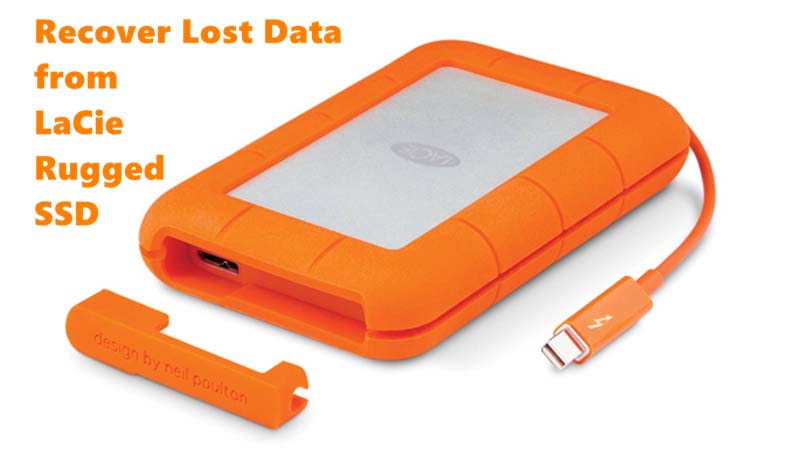Hi, yesterday, I formatted my 1TB LaCie Rugged SSD. When I realized I had made a mistake, all files were gone. Is there any way to recover my lost files?
PAGE CONTENT:
Regarding reliability, speed, and durability, LaCie Rugged SSDs are well-known. It makes them a popular choice for both workers and adventurers. However, even the best storage solutions can lose data if it is deleted by mistake or formatted, the software is corrupted, or the hardware is damaged. Losing important info can be scary and stressful, but it mustn't be a disaster.
This guide will show you how to recover lost data from your LaCie Rugged SSD. It covers everything from using data recovery software to getting help from a professional. Knowing what causes data loss and the best ways to get it back can increase your chances of restoring your important files and ensure your storage device will work for future use.

Lost Data on Your LaCie Rugged SSD?
Signs of data loss:
- Missing Files: You can't see files that you knew were there.
- Unrecognized Drive: Your machine isn't seeing the SSD.
- Error Messages: Error messages say the drive or file system is failing.
- Slow Performance: The drive slows down, which could mean problems.
Preparing for data recovery:
To avoid losing more data, doing some things before recovering the data is important.
- Stop Using the SSD: If you keep using the SSD after you've lost them, you might lose the lost files, which could make recovery harder or even impossible.
- Assess the Situation: Find out why the data was lost so you can choose the best way to get it back. For instance, professional help may be needed for physical damage, but repair software can often fix software problems.
- Backup Remaining Data: If you can still get to the SSD, back up any data you still have so you don't lose it.
Methods to Recover Data from LaCie Rugged SSD
#1 Use LaCie Data Recovery Software
The LaCie data recovery software (Donemax Data Recovery) is powerful and easy to use. It can help you recover deleted, formatted or lost data from any LaCie Rugged SSD or HDD.
Donemax Data Recovery
- Recover all types of lost files from your LaCie Rugged SSD.
- Recover lost data from LaCie Rugged SSD on Windows or macOS.
- Recover deleted, formatted, inaccessible, corrupted or lost data from LaCie Rugged SSD.
Step 1. Download and install Donemax Data Recovery on your computer, make sure the LaCie Rugged SSD has been connected to the computer. Open Donemax Data Recovery, select the LaCie Rugged SSD to start data recovery.

Step 2. Click on Scan button to deeply scan the LaCie Rugged SSD. It will find all lost files.

Step 3. Once the scan is completed, you can preview all recoverable files. Then select the wanted files, click on Recover button. Choose a location to save these files.

#2 Use Windows File Recovery Tool
You can download the Windows File Recovery. For Windows 10 and up users, you can use it to get back files from external hard drives. It doesn't have a GUI (graphical user interface), so you must use the command line to return the data on your LaCie external hard drive.
- Mount your backup file and write down the letter of the drive it is on.
- Open the Windows File Recovery Tool that you got from the Microsoft Store.
![Open the Windows File Recovery Tool]()
- Type the following instructions, then press "Enter":
winfr E: C:\RecoveredFiles/extensive
Replace "E:" with the letter that comes with your LaCie drive and "C:\RecoveredFiles" with the path on your computer where you want the tool to save the recovered files. To continue, press Y.
![Type the following instructions]()
- When asked to view the recovered files, please wait for the Windows File Recovery Tool to finish its check and press Y. The files will be grouped based on type and stored in your chosen location.
![view the recovered files]()
#3 Use Time Machine on Mac
Another great way to get back lost info on your LaCie external drive is to use Time Machine. However, this method will only work if you back up the external drive with Time Machine on your Mac and use it with your LaCie drive before the data loss.
To get back the files on your LaCie external hard drive using Time Machine on your Mac, do the following:
- You can connect your LaCie drive to your Mac.
- To get to your drive, open Finder and select it from the list of devices on the left.
- Open Time Machine on your computer. To do this, click the Time Machine button in the menu bar at the top of the screen and select Browse Time Machine Backups.
- Use the timeline on the right to pick the right Time Machine backup version.
![Open Time Machine on your computer]()
- Find the info you want to get back and click on it.
- Click the Restore button.
![Click the Restore button]()
#4 Use File History on Windows PC
Use the File History feature on a Windows-based PC to see if you can return the lost info from your LaCie external hard drive. Remember that this choice will only work if you have already set up this tool to back up your drive.
To use File History on Windows to get back files from your LaCie drive, do these things:
- Connect your LaCie hard drive to your PC with a wire.
- After opening it, go to where the deleted files were stored on your USB drive.
- To get to the Properties menu, right-click on the folder or file and choose it from the list.
![right-click on the folder or file and choose it]()
- Click on the Previous Versions tab.
![Click on the Previous Versions tab]()
- Click "Restore" after picking out the files. Keep data from getting overwritten, and it's best to save the files somewhere else (click the button and choose "Restore to").
Conclusion:
It can be hard to regain lost data from a LaCie Rugged SSD, but you can restore your important files with the right method and tools. By learning what causes data loss, using the right repair methods, and stopping it from happening again, you can ensure that your storage device lasts a long time and works well. If you want to recover lost data, this guide will show you the whole process, whether you use data recovery tools, hire a professional, or do it yourself.
Donemax Data Recovery is a powerful LaCie data recovery program. It supports to recover any lost file from your LaCie Rugged SSD. With this software, you even can recover lost data from a damaged LaCie Rugged SSD.
FAQs About LaCie Rugged SSD Data Recovery
1. How to recover lost files from a LaCie Rugged SSD?
- Download and install Donemax Data Recovery, connect the LaCie Rugged SSD to the same computer.
- Open Donemax Data Recovery, select the LaCie Rugged SSD to start data recovery.
- Click on Scan button to deeply scan the LaCie Rugged SSD.
- Preview and save the files.
2. How to unformat a LaCie Rugged SSD?
If you have formatted your LaCie Rugged SSD, stop using it. Run Donemax Data Recovery to scan the formatted LaCie Rugged SSD. It will help you find and recover all lost files.
3. What is the best tool for LaCie Rugged SSD data recovery?
Here are effective LaCie Rugged SSD data recovery tools:
- Windows File Recovery
- Time Machine
- Donemax Data Recovery
- Disk Drill
- Magoshare Data Recovery
Related Articles
- Mar 12, 2025Recover Lost Data from Seagate One Touch SSD: A Complete Guide
- Jan 17, 2025How to Repair and Recover Corrupted PSD Files?
- Mar 03, 2025Recover Lost Data from Nano Memory Card: A Comprehensive Guide
- Nov 04, 2024Recover Emptied Recycle Bin: Recover Permanently Deleted Files
- Feb 21, 2025How to Use Windows File History?
- Mar 04, 2025About PC Cards & Recovering Lost Data from PC Cards

Lucien
Lucien is a writer and a chief programmer of Donemax software who has worked in the company for 5+ years. He has written much of the content on the site and devotes to providing troubleshooting and solution for Windows and Mac users including disk cloning, data recovery, migration, eraser, error fixes.

Gerhard Chou
In order to effectively solve the problems for our customers, every article and troubleshooting solution published on our website has been strictly tested and practiced. Our editors love researching and using computers and testing software, and are willing to help computer users with their problems






